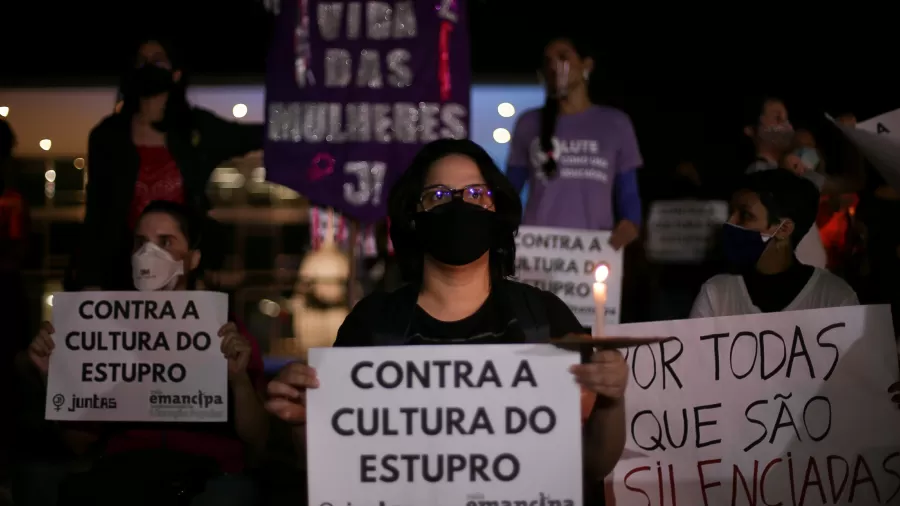Saiu no site THE NEW YORK TIMES:
Veja publicação original: Domestic Abuse, Shown Blow by Blow, Shocks Brazil
.
By Shasta Darlington
.
SÃO PAULO, Brazil — The scenes, captured by security cameras, are gruesome: A man pummels and kicks his wife in the garage of their building. She tries to flee, but he forces her into the elevator. They go up to their fifth-floor apartment.
.
Less than 20 minutes later, he takes the elevator back down — to fetch her bloody, lifeless body, which had plummeted to the sidewalk below.
.
The footage from the night of July 22, first broadcast Sunday on the popular television program Fantástico, has been playing repeatedly on national television. The graphic, blow-by-blow view into what domestic violence really looks like is challenging the widespread notion that you shouldn’t “stick a spoon” in marital disputes.
.
Portions of the video posted by a local newspaper show the woman repeatedly try to get away.
.
.
It also set off a nationwide debate about domestic abuse in Brazil, where almost a third of women say they have suffered violence. According to a 2017 nationwide survey, over half of the attackers were current or former partners.
.
“The video just reflects the levels of violence we have been documenting,” said Maria Laura Canineu, the Brazil director for Human Rights Watch. “What Brazil has to learn is that most of these cases are preventable. It is very rare that a murder is the first case of violence.”
.
The images also show the man, Luís Felipe Manvailer, trying to wipe blood stains off the elevator walls before driving away just as the police arrived. He was quickly apprehended and is being investigated for the murder of his wife of five years, Tatiane Spitzner. Mr. Manvailer denies the accusations, and he told the police that his wife jumped off the balcony.
.
One of the most shocking aspects of the videos is what viewers can’t see: the 15 minutes in which the fighting and beatings are believed to have continued and neighbors reportedly heard desperate screams for help.
.
Ms. Spitzner and Mr. Manvailer married in 2013. The authorities say they found no complaints filed against Mr. Manvailer before the episode in the southern Brazilian town of Guarapuava.
.
But in the widely watched television program, a friend of Ms. Spitzner said she frequently had bruises on her arms, and she sent a WhatsApp message warning that her husband “hated her to death.”
.
On Instagram, Ms. Spitzner’s sister Luana Spitzner created a page called TodosPorTatiane, or Everyone for Tatiane, which was has been followed by 112,000 people. On it, she warns: “Violence leaves marks. Not seeing them leaves femicides.”
.
As the images spread, horrified Brazilians took to Twitter to urge people to intervene to stop domestic violence, posting messages at #metaAcolher, or “stick a spoon in,” a reference to a popular Brazilian saying, “When it’s a fight between husband and wife, don’t stick a spoon in.”
.
One widely shared Twitter message encouraged readers, “When you hear a call for help, stick a spoon in, call the police, try to prevent another femicide — the killing of girls or women, particularly by a man and on account of gender.”
.
Many on social media also used the hashtags #feminicidio and #MariaDaPenha, noting that the violence occurred just before the anniversary of a groundbreaking 2006 domestic abuse law imposing long sentences on offenders and named in honor of a survivor of violence, Maria da Penha.
.
“In Brazil, we have a very good law,” said Ms. Canineu of Human Rights Watch. “The problem is that it’s not being implemented.”
.
The first issue is that only a quarter of women who suffer violence report it to the police.
.
“There are many reasons — stigma, economic dependence or concern for children,” Ms. Canineu said. “But often, it’s the conviction that the state won’t do anything.”
.
Brazil has the seventh-highest rate of femicide in the world, with 4.4 murders per 100,000 women, according to a 2012 Brazilian survey called the Map of Violence. That’s more than double the rate in the United States.
.
Ms. Canineu said that even when women did muster the courage to report violence, the police force’s lack of resources and training often mean the perpetrators did not face any repercussions. Victims are encouraged to go to special police stations for women — but there are very few of these, and they have limited hours.
.
“It’s sad, but maybe something this brutal will wake people up to the reality of domestic abuse,” she said. “Maybe it will mobilize them.”
.
Juliete da Silva Oliveira, a 24-year-old housecleaner, agrees. She said the police laughed at her when she tried to file a restraining order against her former boyfriend, who left death threats on her phone when she tried to leave him. The police dismissed her concern, saying it was normal for guys to get mad when they’re dumped.
.
“He doesn’t have my new address, but I’m still afraid to walk around alone,” she said. “Now maybe people will understand how scary it is.”
.
.
.
.
.
.
.






